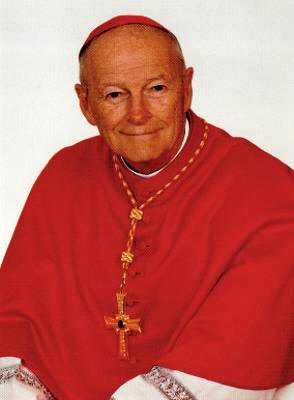|
The
Cardinal McCarrick Syndrome
 In 1990 when I
published my book A Secret World: Sexuality and the Search for
Celibacy a good part of the clerical world rejected the claim
that a large proportion of the clerical community was not practicing
celibacy and that 6 percent of priests had sexual contact with minors.
Some bishops wrote to tell me that my conclusions were
similar to their experience “but I should not have said it.” I was
criticized as being disloyal; my research method also came under
criticism. In 1990 when I
published my book A Secret World: Sexuality and the Search for
Celibacy a good part of the clerical world rejected the claim
that a large proportion of the clerical community was not practicing
celibacy and that 6 percent of priests had sexual contact with minors.
Some bishops wrote to tell me that my conclusions were
similar to their experience “but I should not have said it.” I was
criticized as being disloyal; my research method also came under
criticism.
But in spite of it all,
the conclusions have been tested and found reliable. It is now an
accepted fact that many priests in the United States at any one time are
not practicing celibacy. This was Step One to the beginning of
understanding the problem of clerical celibacy in general and the crisis
of sexual abuse specifically. (Cf. Squabbling About Numbers)
Specifically it was the beginning of spelling out the systemic
construct of the celibate/sexual dynamic in the Catholic Church.
Step Two: With
the hospitalization of priests in the proliferation of mental hospitals
established since 1946 for sexual acting out clergy another insight
became obvious: bishops and superiors knew what was going on. In fact,
as the crisis of abuse took shape it became increasingly apparent that
bishops not only knew what priests were doing to minors, but they were
covering up what they knew and participating in the abuse by
transferring the abusers from one parish or locale to another without
informing or warning anyone of the previous assaults. They blamed
psychiatrists and lawyers for giving them bad advice. (Pope Benedict XVI
recently still used this excuse.) But no bishop needed to be told that
the behavior under question was not celibate. And oversight of priests’
celibacy is the job of the bishop. This basic neglect and undervaluation
of celibacy is a major factor in allowing the abuse of minors. Bishops
dismissed the criminal behavior as being within their province because
it is a “sin.”
Step Three: As the
documentation from civil and criminal cases erupted from every corner of
the States a further element in the dynamic of celibate violation and
sexual abuse revealed itself. That is: The pattern and practice of
superiors, confessors, spiritual directors, novice masters, and faculty
members having sexual exchanges and friendships with seminarians and
young priests. Its prevalence in the United States is unquestionable.
The legal cases that have been filed against priests who have abused
minors are but one source of reliable documentation. Mental health
records are another. Most of all the testimony of the abused is
substantial, painful, pitiful, and disheartening.
A great deal about this element in
the system is well known and also undeniable. The trouble is that it is
sealed within the system. Few of the seminarian/priest victims will talk
on record. They have everything to loose. Sexually active priests who
have no intention of being celibate do everything to cover their tracks.
But the reality goes to the top.
And the pattern is not exclusively homosexual. Bishops and even
cardinals who have more or less long term relationships with women are
known about and there is as-of-yet unpublished documentation. (This
practice used to be called concubinage, was most common and quasi
tolerated. Most the time now these relationships are carried on under
some more dignified word.)
More ominous are the relationships
of sexual sponsorship in which an older priest or superior takes an
attractive and responsive younger priest into his affectionate embrace.
Yes, some of these associations do become sexual. As the senior man
rises in stature, position, and power he brings his protégé along with
him up the scale of the organization. Sometimes the younger man
eventually equals his mentor’s stature; he too can repeat the pattern so
well learned and practiced. This pattern is well exercised in Rome.
There are scores of reliable
documents that demonstrate this practice and people involved.
The main point is that the dynamic
is in operation and affects even good, observant clergy who cannot speak
openly because the secret system will not tolerate them. Where are they
to go? The press will not touch malfeasance on this level of the power
system without impossible vetting that will expose the whistler blower
to potential or certain destruction. Who of the many-in-the-know within
the secret clerical system have that kind of courage?
What I have written to Pope
Benedict (Cf. home page) is but a simple example of the systemic dynamic
of celibate violation within the priesthood and some of the dire
consequences for the church, the clergy, and our youth.
I have expressed my awareness of
how difficult it is even for him to address this dimension of the
problem that I have named the Cardinal McCarrick Syndrome. Great Saints
like Pope Gregory I, Peter Damian, the patron of church reform, and the
other saints illustrated in C. Colt Anderson’s Great Catholic
Reformers have tried, some with more success than others.
(Cf. Books of Note) There is a need for such saints today. The
problem is present, operative, and of major magnitude.
Now Read "Statement
for Pope Benedict XVI" |



